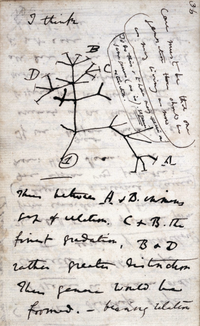
Photo from wikipedia
Evolutionary radiation is a widely recognized mode of species diversification, but its underlying mechanisms have not been unambiguously resolved for species-rich cosmopolitan plant genera. In particular, it remains largely unknown… Click to show full abstract
Evolutionary radiation is a widely recognized mode of species diversification, but its underlying mechanisms have not been unambiguously resolved for species-rich cosmopolitan plant genera. In particular, it remains largely unknown how biological and environmental factors have jointly driven its occurrence in specific regions. Here we use Rhododendron, the largest genus of woody plants in the Northern Hemisphere, to investigate how geographic and climatic factors, as well as functional traits, worked together to trigger plant evolutionary radiations and shape the global patterns of species richness based on a solid species phylogeny. Using 3437 orthologous nuclear genes, we reconstructed the first highly supported and dated backbone phylogeny of Rhododendron comprising 200 species that represent all subgenera, sections, and nearly all multi-species subsections, and found that most extant species originated by evolutionary radiations when the genus migrated southwards from circumboreal areas to tropical/subtropical mountains, showing rapid increases of both net diversification rate and evolutionary rate of environmental factors in the Miocene. We also found that the geographically uneven diversification of Rhododendron led to a much higher diversity in Asia than in other continents, which was mainly driven by two environmental variables, i.e., elevation range and annual precipitation, and were further strengthened by the adaptation of leaf functional traits. Our study provides a good example of integrating phylogenomic and ecological analyses in deciphering the mechanisms of plant evolutionary radiations, and sheds new light on how the intensification of the Asian monsoon has driven evolutionary radiations in large plant genera of the Himalaya-Hengduan Mountains.
Journal Title: Molecular biology and evolution
Year Published: 2021
Link to full text (if available)
Share on Social Media: Sign Up to like & get
recommendations!